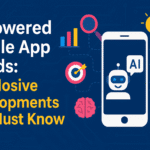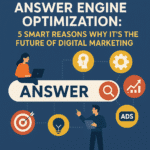
Answer Engine Optimization is not just a buzzword—it’s a necessary shift in how we approach digital marketing today. As AI tools like ChatGPT, Google’s SGE, and voice assistants gain popularity, traditional SEO techniques are no longer enough. If you want your content to be seen, heard, and cited by AI, you need to optimise for answers, not just keywords.
I first encountered AEO while testing chatbot visibility for my agency blog. To my surprise, a single Q&A-formatted section landed us in a ChatGPT snippet. That experience changed everything.
What is Answer Engine Optimization?
Answer Engine Optimization (AEO) is the process of structuring your content so that AI-powered tools can extract direct, concise answers to user queries. It’s similar to SEO but tailored for zero-click environments—think AI-generated summaries, voice search, and featured snippets.
Unlike traditional SEO, AEO focuses more on:
- Clarity and conciseness
- Structured formats like FAQs and tables
- Authoritative sources and citations
- Conversational language patterns
According to Search Engine Journal, AEO is already driving significant visibility in tools like Google’s AI Overviews and Microsoft Copilot.
Why Should Digital Marketers Care About AEO?
Here are 5 smart reasons why I believe every serious marketer should prioritise AEO in 2025:
1. Reduced Organic Clicks Demand AI Visibility
Traditional SEO is losing clicks due to AI previews and zero-click results. AEO ensures your content is still seen—even if no one visits your page.
2. Optimising for Voice Search
Most voice assistants rely on short, structured answers. AEO helps you tailor your content to match natural speech patterns and command formats.
3. Higher Trust Through Citations
AI models prefer citing authoritative pages. By linking to credible sources and formatting your content with clear, fact-based answers, you increase your chances of being quoted. (Check out our article on Micro‑Influencer Marketing for a practical example.)
4. Early Adopter Advantage
Since AEO is still emerging, competition is relatively low. Smart brands that implement AEO now will enjoy early mover benefits.
5. Improved Content Structure
Even if AI weren’t involved, AEO makes your content more readable for humans. Better UX often translates into longer time-on-page and stronger engagement.
How to Implement Answer Engine Optimization (Step-by-Step)
Here’s a breakdown of how I approach AEO for my clients:
Step 1: Start with Intent-Focused Keyword Research
Use tools like Semrush, Ahrefs, and Google’s Keyword Planner to find question-based queries. Look for long-tail keywords with informational or transactional intent.
Step 2: Optimise Content for Direct Answers
Write 40–60 word answers at the top of your pages. Use clear H2 and H3 headings to introduce each topic. Keep language simple, factual, and conversational.
Step 3: Use Structured Data Markup
Use FAQ schema, HowTo schema, and other JSON-LD structures to signal your page’s layout to AI bots. Google’s Rich Results Test tool can help verify if your markup is valid.
Step 4: Link to Authoritative Sources
Google’s and Bing’s AI engines cite trusted sources. Include at least 1–2 external links to sources like Moz, HubSpot, or Search Engine Journal.
Step 5: Refresh Content Regularly
AI engines favour updated content. Make sure your facts, stats, and answers are fresh. AEO isn’t a “set it and forget it” strategy.
Real-World Examples of AEO in Action
One of our clients in the SaaS space implemented Answer Engine Optimization across their support articles. Within 30 days, their help docs were appearing in Microsoft Copilot responses.
Another brand, a Nigerian EdTech startup, restructured their blog posts with FAQs and noticed improved visibility across Gemini AI and Perplexity.
Alt text example: “Answer Engine Optimization success chart for EdTech startup”
Tools to Improve Your Answer Engine Optimization Strategy
Here are tools I recommend:
- AlsoAsked – For identifying related questions
- AnswerThePublic – Visualise question-based search demand
- Semrush – For keyword clustering and competition analysis
- Google Search Console – Monitor how Google reads your structured content
- ChatGPT – Test if your content is being used in AI-generated answers
Related to AEO
AEO works best when your internal link structure supports it. You can link to:
- Related tutorials (How to Create a Digital Marketing Strategy)
- Supporting guides (Micro-Influencer Marketing Strategy)
Use descriptive anchor text like “AEO implementation guide” or “AI-powered search techniques.”
Best Practices for Alt Text in AEO
AI bots scan alt text too. Include your focus keyword where appropriate. For example:
- “Answer Engine Optimization comparison chart”
- “AEO keyword structure template”
Avoid stuffing; be relevant and readable.
Common Mistakes to Avoid with AEO
- Overloading pages with keywords instead of actual answers
- Ignoring structured data markup
- Using clickbait headlines that confuse AI tools
- Skipping authoritative outbound links
- Failing to update outdated content
Conclusion: Final Takeaway
If you’re still relying solely on traditional SEO, you’re missing out on how people and machines interact with search today. Answer Engine Optimization is more than a trend—it’s a transformation. Start small. Restructure a few blog posts, add structured data, and track results.
As I often tell my clients: “Don’t just try to rank. Try to answer.”
Ready to implement AEO? Share this with your team or bookmark it for your next strategy meeting.
Quick Recap
- Focus keyword: Answer Engine Optimization
- Why it matters: AEO boosts visibility in AI tools and zero-click environments
- Main benefits: More citations, better UX, early adopter advantage
- Tools to use: AlsoAsked, Semrush, ChatGPT, GSC
- Pro tip: Structure your answers and use schema
FAQ: Answer Engine Optimization
Q1: Is AEO replacing SEO?
Not entirely. AEO complements SEO by preparing content for AI-based tools and voice search, rather than traditional ranking alone.
Q2: How often should I update AEO content?
At least every quarter. AI tools prefer fresh data and reliable information.
Q3: Can small businesses benefit from AEO?
Absolutely. Fewer competitors in AEO mean small brands can stand out faster than in traditional SEO spaces.
Q4: What’s the ideal content length for AEO?
800–2,000 words with well-structured Q&As and summarised answers upfront.
Q5: Does AEO work for local businesses?
Yes. Combine AEO with local SEO for visibility in tools like Google Maps and voice assistants.




